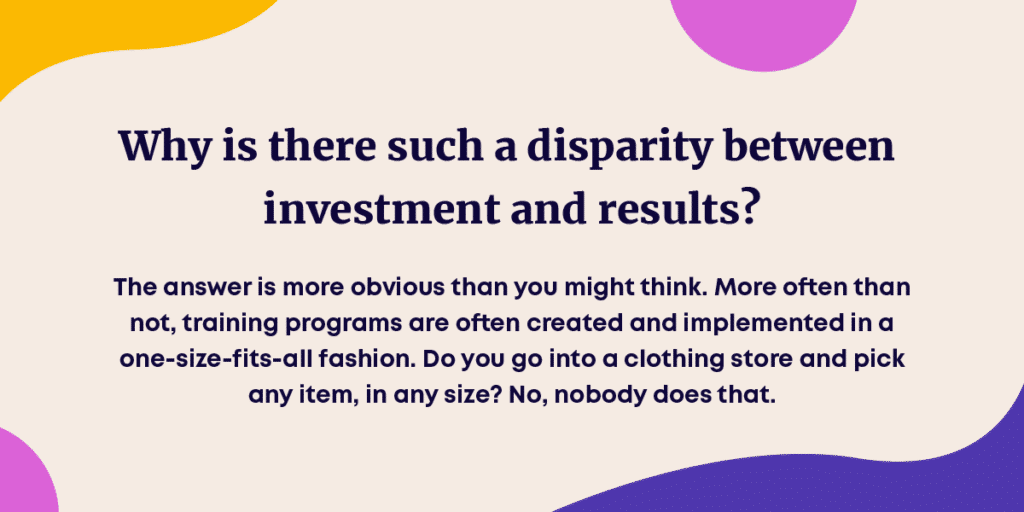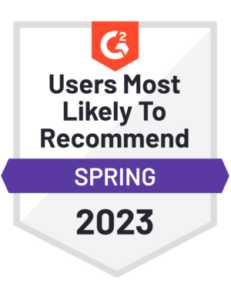Training needs to change. With hundreds of billions spent annually on training and development, you might assume that team leaders report plenty of satisfaction, visible results, and enthusiasm to learn. The truth is: this often isn’t the case. Sadly, the reality is that many managers are left dissatisfied by L&D programs and employees don’t master the skills they need to be trained in.
This leads to low retention rates of new knowledge, with minimal improvements in performance. Why is there such a disparity between investment and results? The answer is more obvious than you might think.

More often than not, training programs are often created and implemented in a one-size-fits-all fashion. Do you go into a clothing store and pick any item, in any size? No, nobody does that. The secret to good L&D is the same as the secret to good fashion: tailoring to the occasion and the individual makes all the difference. And tailoring educational programs is what we at Claned provide.
Want to learn more? Of course you do! Let’s take an opportunity to do a lil’ deep dive into where training goes wrong and how to change it.
So… why does L&D training often go wrong?
What does a skyscraper, a fifty-year marriage, and great L&D have in common? All have a solid foundation built on communication and shared values. Bad L&D often takes place because the two parties (the employer and the employee) aren’t seeing eye to eye on the “why” of the learning.
Learners in any field are motivated by two big factors: internal and external motivation. Internal motivation occurs when a learner is motivated internally by their own desire to develop new skills and expand their knowledge: they may find it enjoyable, or want to see the direct benefits of gaining new skills and knowledge because they know it will help them.
External motivation, on the other hand, basically means that the employee motivator is a “thing” — think of the classic “horse and carrot” example — the horse always wants the carrot, so it moves forward. But if you take away the carrot, the horse becomes unmotivated. Likewise, the “why” disappears as soon as the employee gets the prize: be it a promotion, bragging rights, or increased status among peers and co-workers.
Relying exclusively or heavily on extrinsic motivation is not sustainable and often leads to boredom, lack of engagement, and low retention/outcomes. This is common when organizations “keep score” and just use completion as the main (or only) measure of their development programs. If this is the benchmark by which L&D developers contribution is measured they too will become motivated not by creating meaningful, impact driven, useful trainings, but instead by how many points they get employees to rack up.
Everybody loses. To be a great teacher, you have to be a good student. Intrinsic learning is something CLANED can help your company provide.

Timing is critical when it comes to training
Why is a particular training being done at a given time? Is it just mandated or does it relate to the real world situations and needs of the employees? Identifying the types of goals that are effective in producing motivation in employees is critical to delivering training programs with impact. By understanding what type of goals individual employees are trying to achieve, training and development programs which support their efforts can be implemented.
The effect of just simply understanding a shared goal between employee and employer is staggering. Those taking the training will be motivated to complete the training because they will see the direct benefit to their work. Employers will find that trainings are more likely to have a measurable positive impact on the company, because the training is inherently tied to the challenges faced.
The forgetting curve
Its well known that we (human beings) forget a lot of the information we take in. This is part of life, and it’s OK to forget non-critical information. Imagine remembering every place you’ve parked your car for the last 3 years: it’d be exhausting! So how do our brains distinguish between useful and frivolous information? While we don’t know the complete answer to this we know that is big part of it is that humans often are able to recall information that is frequently used.
This means that whatever training is being provided, learners should have the opportunity and need to apply it on a regular basis. Using information on the job in the real world will not only increase learners motivation but enforces remembering it. In short: there’s your “why”!

This is a great opportunity to jump to the next segment. You’ve learned why training goes wrong, so now it’s time to learn…
How to make learning during training better
Companies constantly seek employees that are adaptable, can pivot quickly, and are good at constantly developing. However, companies themselves often fail at the very skills they’re looking for in others. Here’s some great tricks to change internally:
- Apply new skills and knowledge immediately to real-world situations so the benefit becomes visible.
- Encourage and provide constructive feedback quickly.
- Foster a culture where questions are welcomed.
- Acknowledge that learning is an ongoing process.
- Strive for improvement, not perfection! Use Claned’s Learning Design tools to assess what was done in previous iterations and what could be improved upon in the future.

A lot of what’s been discussed here could be considered “Lean Learning”. So what are the key principals for implementing lean learning in an organization?
Apply learning to real world situations
Knowing something and applying it are two separate concepts. You don’t learn to drive through reading books and watching videos… you learn to drive in a car. The same is true for any training or development you want to bring into your organization: put the employee in the driver’s seat of their own success.
Want to up-skill employees for handling a specific kind of client request? People learn by example, so use existing cases that they will recognize or be familiar with and get them to apply the new knowledge. This makes the outcomes of learning tangible for learners, they can see a direct benefit and effect of knowing and using the information you’ll deliver through the training program.
Use guided learning
Don’t expect everyone to learn everything all at once, or even in the same order. By guided learning what we mean is to have learning and development programs always available, and direct people to them when they need it and when it makes sense. Are they struggling with a particular software, great direct them to the course for it.
The main idea here is to recognize that people are individuals and to try to make learning and development paths and opportunities fit and support their needs as individuals. Luckily with online learning its easy to have a number of different training and development courses available, and allow employees to sign-up, and follow them as and when needed. You may even consider having a public list of what’s available, you may find people interested in trainings they would have otherwise not know were available.
Personalize content of your training
Using real-world context and situations in learning and development programs is a great way to ensure success. By offering a choice of assignments, materials, and delivery methods/outputs for learners with a variety of focuses, this allows team leaders to further tailor the learning to an employee or a department’s specific needs.
READ: 5 Best Customer Training LMS
Provide continuous support
Professional learning and development never should be confined to the course itself. By ensuring employees have access to a variety of channels for support, guidance and feedback in their learning, you can ensure their continued success.
Apply peer learning
Your best asset for employee L&D is right in front of you: your employees. By pooling know the collective experience of everyone there, use this. Allow those who are experts in applicable areas to run workshops, or ask if they can assist in the support and training of others. By fostering a community of practice, support, and knowledge you can ensure the success of all your team members, not just the top 10%.
Use micro-learning
Let’s be real. People are busy, and a training course is likely not the only thing that an employee will need to focus on in a given day. One way of acknowledging this and taking an actionable step is to allow a micro-learning mentality. This means breaking down information and lessons into bite-size pieces; five to fifteen minutes per piece of info is usually more than enough.
This practice may take some additional effort up front from the L&D team (or your content providers), but the results are very much worth it. The learning becomes more approachable and manageable for learners, ultimately leading to better results and motivation.
Change focus and measure outcomes
Everyone learns differently. 100% completion should not be the main focus, as “rushing to the end” is what creates knowledge gaps in the first place! Instead, figure out what measurable and meaningful outcomes or KPI’s can be identified and measure success by changes in these numbers.
With a modern LMS/LXP like CLANED®, getting data and analytics from learning courses is easy. With CLANED data you can paint a vivid picture of the effectiveness and outcomes of trainings and adjust courses to see the results you need.
Reward progress and achievement
Learning takes work! Acknowledge it. Something as simple and easy as a positive comment can go a long way, as can bigger motivators like snacks and small gifts. Some employees may jump at the chance to present to the team what they’ve learned, others may be more motivated by a pizza.
Every employee is different, but one thing everyone can enjoy is a manager acknowledging their hard work. These may seem like small and obvious things but the effect they can have should not be ignored or underrated.
If you’d like to read more content like this, then check out Teemu‘s post on How to make your corporate training more successful.







